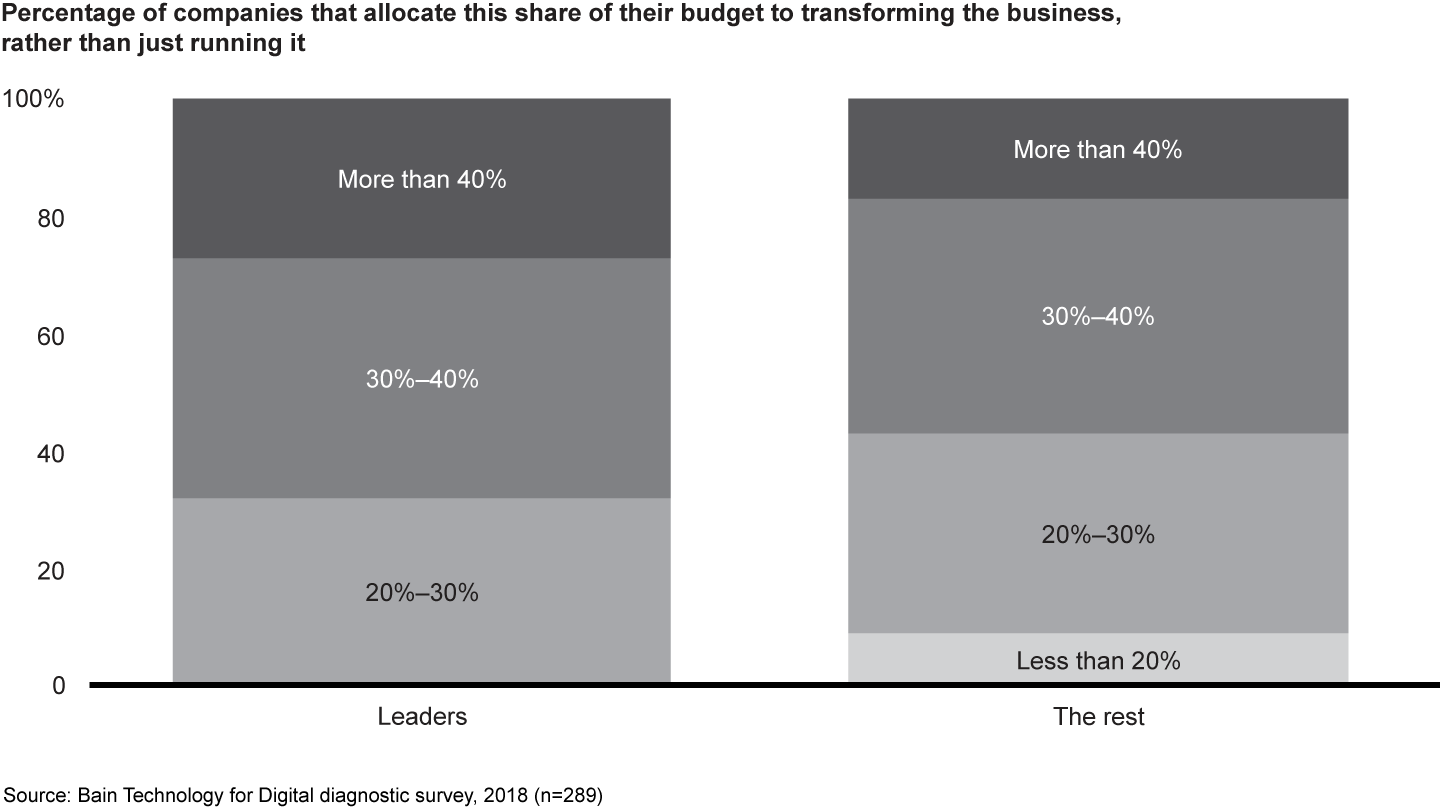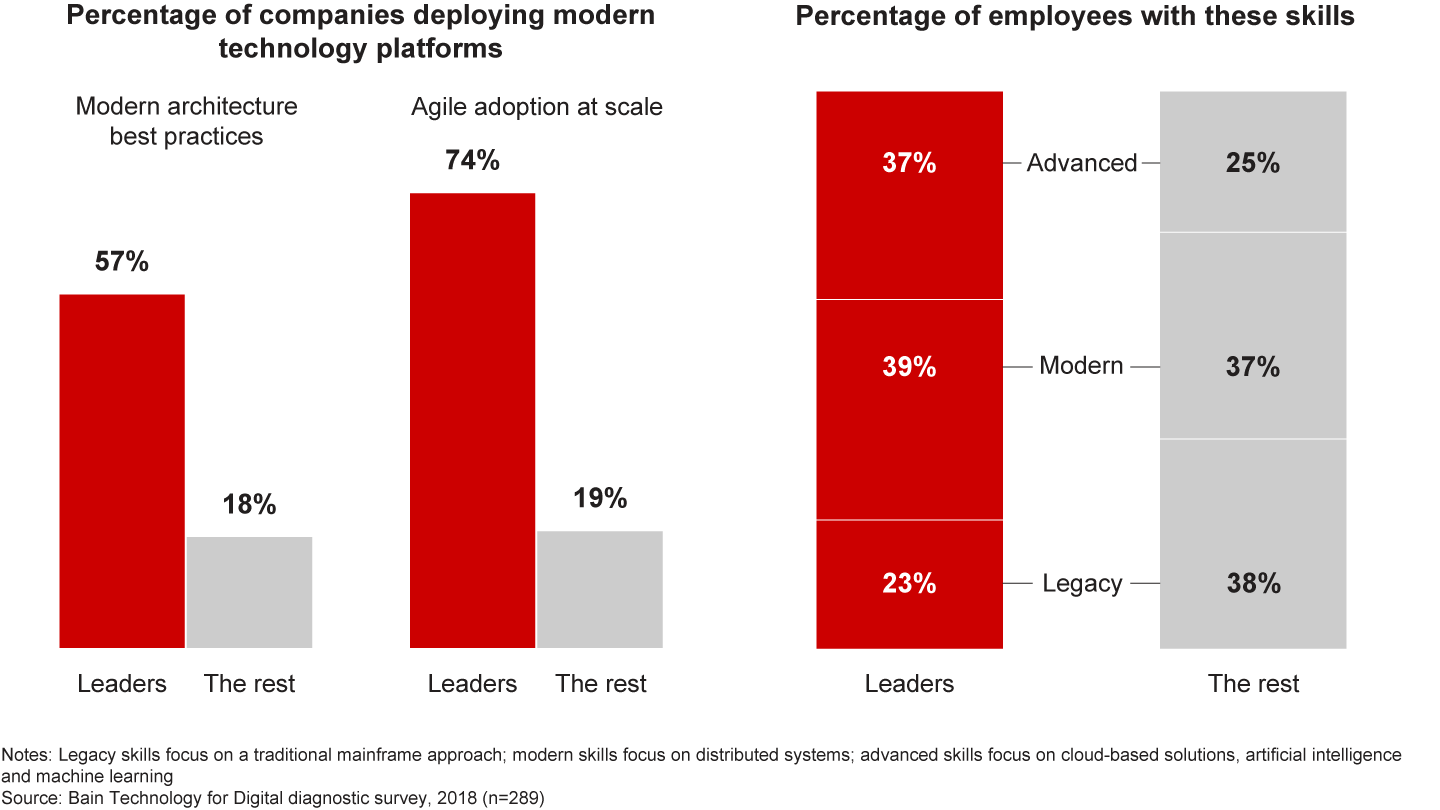Article
 }
}
Nearly every company is involved in some form of digital transformation, but how many are actually seeing it pay off?
The answer is surprisingly few. New research by Bain & Company finds that only 8% of global companies have been able to achieve their targeted business outcomes from their investments in digital technology. Said another way, more than 90% of companies are still struggling to deliver on the promise of a technology-enabled business model.
What secret formula do the 8% deploy? Unsurprisingly, there are no shortcuts or silver bullet. But successful transformations do share some common themes.
One of the most important is understanding that this is really a business transformation, supported by investments in new technology—not new technology in search of opportunities. Many executives pay lip service to this idea, but in practice, they delegate too much responsibility to the tech team, hoping the business can watch from the sidelines. At the 8%, executive teams understand that the core of a digital transformation is a business transformation, changing the way of engaging customers across channels, simplifying business processes, and redesigning products or services. Rather than asking which technologies they should add to become more digital, the 8% ask how they can improve the business and how technology can enable that change.
A good example comes from a global insurer, which went through a technology transformation earlier this decade. One of the first decisions that senior executives made was to standardize products and services. They realized that customization does not necessarily deliver differentiation, though it almost always increases costs. By standardizing business and product design in up to 80% of their workflows, they were able to develop new capabilities and deliver faster than competitors. A technology function working on its own would not have been able to drive this standardization because it involved business process and product redesign.
Our work with companies undergoing technology transformations reveals several myths that are widely believed among executives—and that, unless dispelled, can hinder success.
- Myth 1: You can spend your way to leadership. Our research shows that leaders—the 8%—don’t spend much more on technology than others do. In some cases, they actually spend a lot less. But they do spend differently. Leaders invest more to develop new products and services, and less on keeping legacy systems running (see Figure 1). They also find ways to self-fund some of their transformation expenses by eliminating lower-value business projects and selectively deploying new technologies to reduce operating expenses. They are transparent about costs, optimize sourcing, manage demand closely, and simplify systems and processes where possible. Over the course of a major digital transformation, a US retailer cut technology spending by 40% and was able to deliver four times more productivity by building up its internal talent pool, adopting Agile and DevOps methodologies, spending less on external vendors, and redesigning the architecture of its applications and infrastructure.


- Myth 2: Setting up Agile teams will be enough to deliver high-quality solutions quickly. Modern IT depends on Agile, but Agile alone is not enough. Companies need to synchronize their progress on Agile with their efforts to modernize architecture and develop new talent (see Figure 2). No company is a leader in one without addressing all three. Digital natives like Amazon and Netflix, as well as companies like Target and Capital One, recognized this truth early and designed their transformations accordingly. (For more, read “Agile Is Not Enough” in MIT Sloan Management Review.)


- Myth 3: Investing in data analytics or customer engagement will be enough. Focusing on only one aspect of digitalization—for example, improving customer experience or building better analytics capabilities—won’t deliver a successful transformation. Leaders modernize their foundational infrastructure, remove legacy bottlenecks and address core technology issues such as integration and developing a service-oriented architecture. Executives at Lyft realized this as they were moving to adapt a monolithic core system that was limiting their ability to scale. Over about two years, Lyft redesigned its architecture into a series of microservices that increased speed—a significant investment, but one that the company thought necessary to achieve its strategic goals. Other companies such as Target and Capital One have also invested in architecture modernization, as did Amazon in the early 2000s, when it modularized its monolithic technology stack to lay the foundation for the explosive business growth it foresaw.
- Myth 4: To succeed, you need to do everything at once. In reality, doing everything at once increases the risk of failure. Winners prioritize initiatives and carefully design transformation plans that produce a cadence of improvement. They don’t try to become best in class everywhere, only where it matters most to their business. A European bank that had wrestled with an ambitious transformation of its core banking system wasn’t seeing the progress it wanted. By pausing to reorchestrate the migration plans, the bank was able to focus on delivering progress in the areas that mattered most. A redefined business transformation plan that mapped out staged progress has allowed the bank to meet its strategic goals.
Of course, merely countering these myths will not necessarily move a company into the 8%, the elite cadre of companies that are seeing real value from their investments in digital technology. But clearly grasping what is necessary—and acknowledging that change is difficult—may be the first steps in a renewed approach to a successful transformation.
Vishy Padmanabhan, Steve Berez and Pascal Gautheron are partners with Bain & Company’s Technology and Analytics Group, based in New York, Boston and Sydney, respectively.